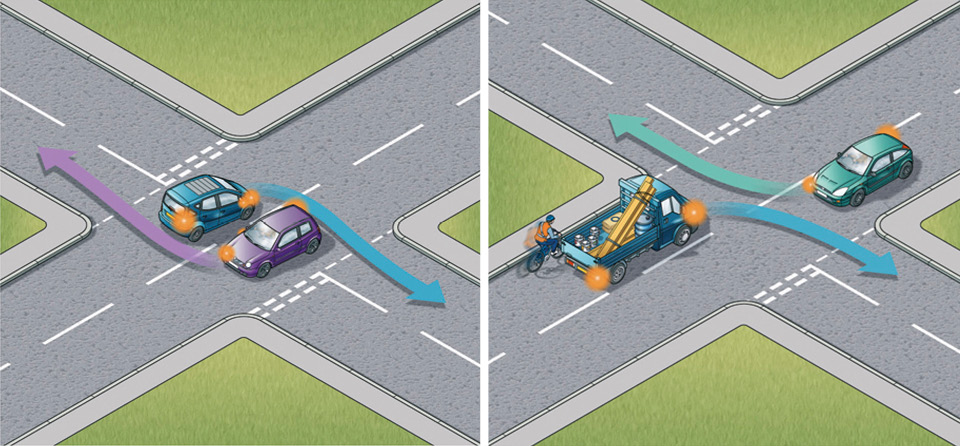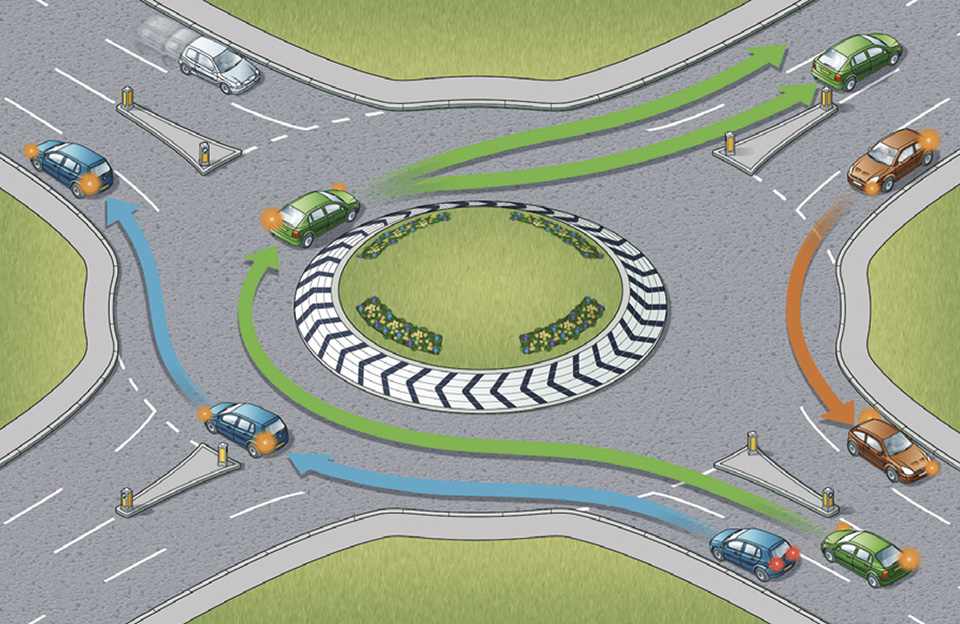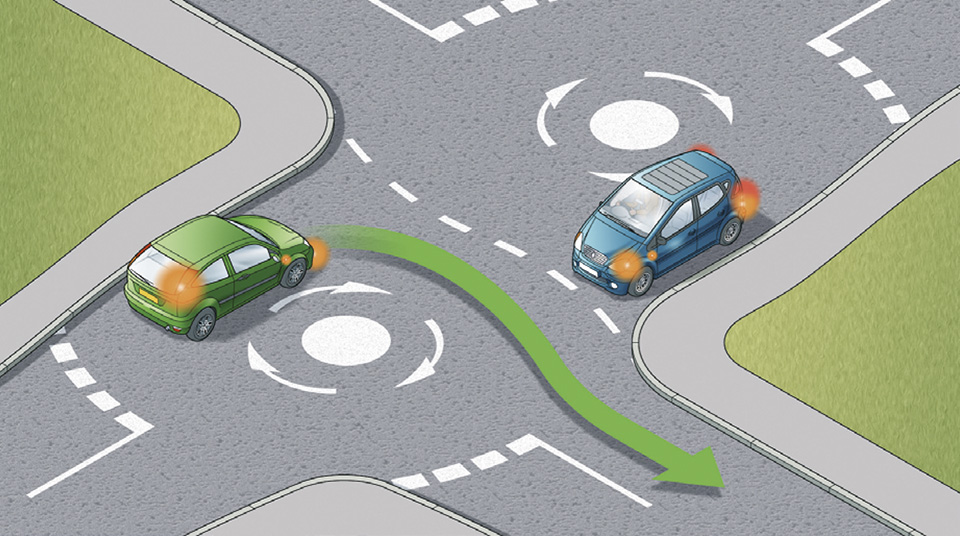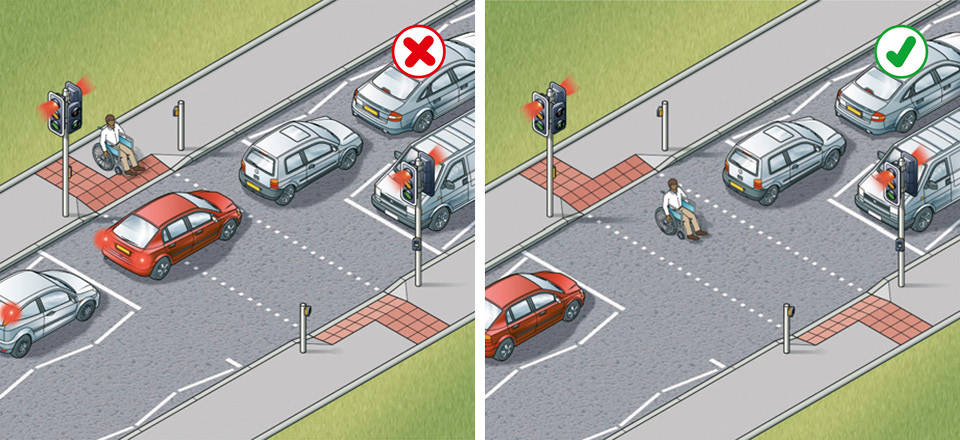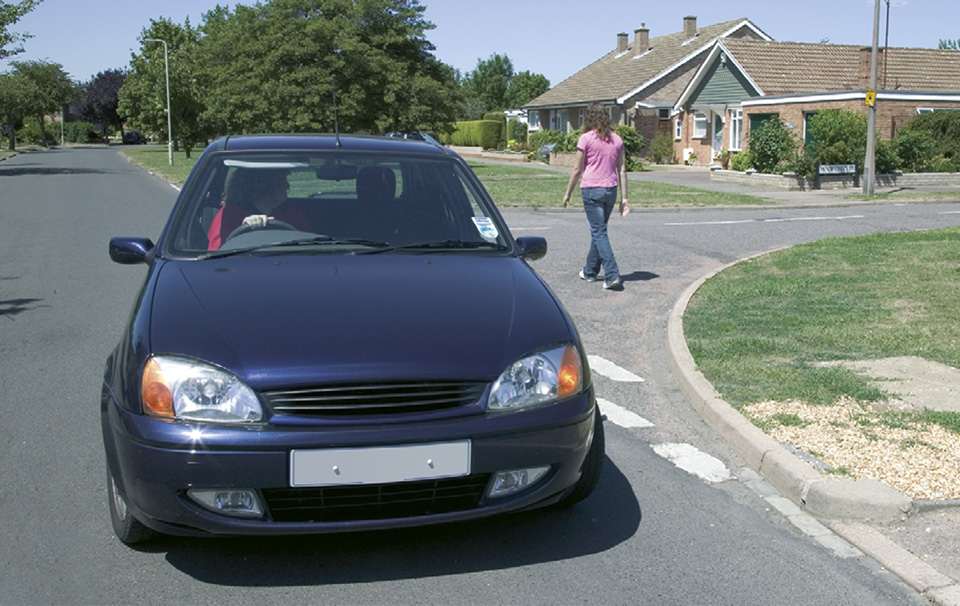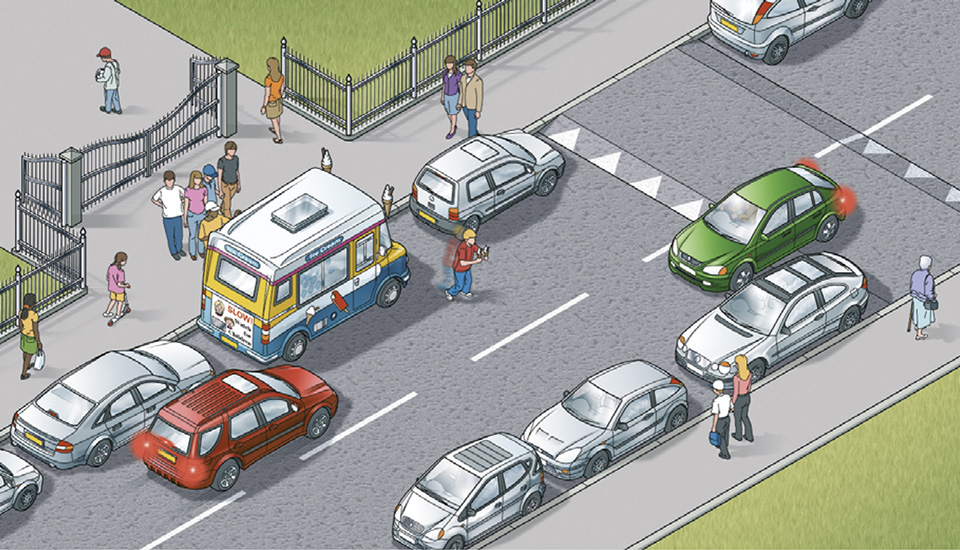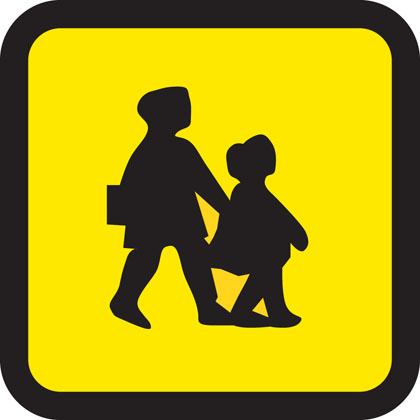- Drivers
- Motorcyclists
- Pedestrians
- Cyclists
- Children
- Horse riders
- Users of powered wheelchairs and mobility scooters
The Highway Code includes hundreds of rules, many of which are legal requirements. Violating these rules is a criminal offence which may lead to a fine, penalty points, disqualification from driving or being sent to prison in the most serious cases.
As a learner driver, knowledge and understanding of the Highway Code is essential. The questions that make up the driving theory test are derived from the Code so it is vital you revisit it regularly during your learning. We have set up this resource to aid your learning. You may browse the Highway Code rules below or use the search facility to find specific rules pertaining to a particular topic. For example, if you’re looking for information about “box junctions”, type in this term in the search box and hit enter. The rule containing information about this topic will appear (Rule 174). You may also save certain rules that you want to revisit at a later stage. By signing up for an account, you can access these saved rules in your dashboard.
If it has been a while since you took your test, you may not have looked at The Highway Code for a number of years. Just as driving or riding skills evolve and develop with time and experience, the rules and advice given in the Highway Code also change and evolve over time, for any number of reasons. Knowing and applying all the rules could help significantly reduce the number of road casualties. This is a responsibility we all share.
Ultimately, it is up to you to acquire and retain the knowledge contained in The Highway Code, regardless of whether you are a pedestrian or the user of any type of vehicle. It is your responsibility to ensure you keep up to date with the rules in The Highway Code – ignorance is no defence.
307 Highway Code Rules
Highway Code Rule 181
When turning right at crossroads where an oncoming vehicle is also turning right, there is a choice of two methods
- turn right side to right side; keep the other vehicle on your right and turn behind it. This is generally the safer method as you have a clear view of any approaching traffic when completing your turn
- left side to left side, turning in front of each other. This can block your view of oncoming vehicles, so take extra care. Cyclists and motorcyclists in particular may be hidden from your view. Road layout, markings or how the other vehicle is positioned can determine which course should be taken.
Highway Code Rule 182
Use your mirrors and give a left-turn signal well before you turn left. Do not overtake just before you turn left and watch out for traffic coming up on your left before you make the turn, especially if driving a large vehicle. Cyclists, motorcyclists and other road users in particular may be hidden from your view.
Highway Code Rule 183
When turning
- keep as close to the left as is safe and practicable
- give way to any vehicles using a bus lane, cycle lane, cycle track or tramway from either direction, including when they are passing slow moving or stationary vehicles on either side.
Highway Code Rule 184
On approaching a roundabout take notice and act on all the information available to you, including traffic signs, traffic lights and lane markings which direct you into the correct lane. You should
- use Mirrors – Signal – Manoeuvre at all stages
- decide as early as possible which exit you need to take
- give an appropriate signal (see Rule 186, below). Time your signals so as not to confuse other road users
- get into the correct lane
- adjust your speed and position to fit in with traffic conditions
- be aware of the speed and position of all the road users around you.
Highway Code Rule 185
When reaching the roundabout you should
- give priority to traffic approaching from your right, unless directed otherwise by signs, road markings or traffic lights
- check whether road markings allow you to enter the roundabout without giving way. If so, proceed, but still look to the right before joining
- watch out for all other road users already on the roundabout; be aware they may not be signalling correctly or at all
- look forward before moving off to make sure traffic in front has moved off.
Highway Code Rule 186
Signals and position. When taking the first exit to the left, unless signs or markings indicate otherwise
- signal left and approach in the left-hand lane
- keep to the left on the roundabout and continue signalling left to leave.
When taking an exit to the right or going full circle, unless signs or markings indicate otherwise
- signal right and approach in the right-hand lane
- keep to the right on the roundabout until you need to change lanes to exit the roundabout
- signal left after you have passed the exit before the one you want.
When taking any intermediate exit, unless signs or markings indicate otherwise
- select the appropriate lane on approach to the roundabout
- you should not normally need to signal on approach
- stay in this lane until you need to alter course to exit the roundabout
- signal left after you have passed the exit before the one you want.
When there are more than three lanes at the entrance to a roundabout, use the most appropriate lane on approach and through it.
You should give priority to cyclists on the roundabout. They will be travelling more slowly than motorised traffic. Give them plenty of room and do not attempt to overtake them within their lane. Allow them to move across your path as they travel around the roundabout.
Cyclists, horse riders and horse drawn vehicles may stay in the left-hand lane when they intend to continue across or around the roundabout and should signal right to show you they are not leaving the roundabout. Drivers should take extra care when entering a roundabout to ensure that they do not cut across cyclists, horse riders or horse drawn vehicles in the left-hand lane, who are continuing around the roundabout.
Highway Code Rule 187
In all cases watch out for and give plenty of room to
- pedestrians who may be crossing the approach and exit roads
- traffic crossing in front of you on the roundabout, especially vehicles intending to leave by the next exit
- traffic which may be straddling lanes or positioned incorrectly
- motorcyclists
- long vehicles (including those towing trailers). These might have to take a different course or straddle lanes either approaching or on the roundabout because of their length. Watch out for their signals.
Highway Code Rule 188
Mini-roundabouts. Approach these in the same way as normal roundabouts. All vehicles MUST pass round the central markings except large vehicles which are physically incapable of doing so. Remember, there is less space to manoeuvre and less time to signal. Avoid making U-turns at mini-roundabouts. Beware of others doing this.
Laws
Highway Code Rule 189
At double mini-roundabouts treat each roundabout separately and give way to traffic from the right.
Highway Code Rule 191
You MUST NOT park on a crossing or in the area covered by the zig-zag lines. You MUST NOT overtake the moving vehicle nearest the crossing or the vehicle nearest the crossing which has stopped to give way to pedestrians.
Laws
Highway Code Rule 192
In slow-moving and queuing traffic you should keep crossings completely clear, as blocking these makes it difficult and dangerous for pedestrians to cross. You should not enter a pedestrian crossing if you are unable to completely clear the crossing. Nor should you block advanced stop lines for cycles.
Highway Code Rule 193
You should take extra care where the view of either side of the crossing is blocked by queuing traffic or incorrectly parked vehicles. Pedestrians may be crossing between stationary vehicles.
Highway Code Rule 194
Allow pedestrians plenty of time to cross and do not harass them by revving your engine or edging forward.
Highway Code Rule 195
Zebra and parallel crossings. As you approach a zebra crossing
- look out for pedestrians waiting to cross and be ready to slow down or stop to let them cross
- you should give way to pedestrians waiting to cross
- you MUST give way when a pedestrian has moved onto a crossing
- allow more time for stopping on wet or icy roads
- do not wave, flash your lights or use your horn to invite pedestrians across; this could be dangerous if another vehicle is approaching
- be patient, do not sound your horn or rev your engine as this can be intimidating
- be aware of pedestrians approaching from the side of the crossing.
A zebra crossing with a central island is two separate crossings (see Rules 19 and 20).
Parallel crossings are similar to zebra crossings, but include a cycle route alongside the black and white stripes.
As you approach a parallel crossing
- look out for pedestrians or cyclists waiting to cross and slow down or stop
- you should give way to pedestrians or cyclists waiting to cross
- you MUST give way when a pedestrian or cyclist has moved onto a crossing
- allow more time for stopping on wet or icy roads
- do not wave, flash your lights or use your horn to invite pedestrians or cyclists across; this could be dangerous if another vehicle is approaching
- be patient, do not sound your horn or rev your engine as this can be intimidating
- be aware of pedestrians or cyclists approaching from the side of the crossing.
A parallel crossing with a central island is two separate crossings (see Rules 19 and 20).
Law
Highway Code Rule 196
Pelican crossings. These are signal-controlled crossings where flashing amber follows the red ‘Stop’ light. You MUST stop when the red light shows. When the amber light is flashing, you MUST give way to any pedestrians on the crossing. If the amber light is flashing and there are no pedestrians on the crossing, you may proceed with caution.
Laws
Highway Code Rule 197
Pelican crossings which go straight across the road are one crossing, even when there is a central island. You MUST wait for pedestrians who are crossing from the other side of the island.
Laws
Highway Code Rule 198
Give way to anyone still crossing after the signal for vehicles has changed to green. This advice applies to all crossings.
Highway Code Rule 199
Toucan, puffin and equestrian crossings. These are similar to pelican crossings, but there is no flashing amber phase; the light sequence for traffic at these three crossings is the same as at traffic lights. If the signal-controlled crossing is not working, proceed with extreme caution. Do not enter the crossing if you are unable to completely clear it, to avoid obstructing pedestrians, cyclists or horse riders.
Highway Code Rule 200
Choose an appropriate place to manoeuvre. If you need to turn your vehicle around, wait until you find a safe place. Try not to reverse or turn round in a busy road; find a quiet side road or drive round a block of side streets.
Highway Code Rule 201
Do not reverse from a side road into a main road. When using a driveway, reverse in and drive out if you can.
Highway Code Rule 202
Look carefully before you start reversing. You should
- use all your mirrors
- check the ‘blind spot’ behind you (the part of the road you cannot see easily in the mirrors)
- check there are no pedestrians (particularly children), cyclists, other road users or obstructions in the road behind you.
Reverse slowly while
- checking all around
- looking mainly through the rear window
- being aware that the front of your vehicle will swing out as you turn.
Get someone to guide you if you cannot see clearly.
Highway Code Rule 203
You MUST NOT reverse your vehicle further than necessary.
Law
Highway Code Rule 204
The road users most at risk from road traffic are pedestrians, in particular children, older adults and disabled people, cyclists, horse riders and motorcyclists. It is particularly important to be aware of children, older adults and disabled people, and learner and inexperienced drivers and riders. In any interaction between road users, those who can cause the greatest harm have the greatest responsibility to reduce the danger or threat they pose to others.
Highway Code Rule 205
There is a risk of pedestrians, especially children, stepping unexpectedly into the road. You should drive with the safety of children in mind at a speed suitable for the conditions.
Highway Code Rule 206
Drive carefully and slowly when
- in crowded shopping streets, Home Zones and Quiet Lanes (see Rule 218) or residential areas
- driving past bus and tram stops; pedestrians may emerge suddenly into the road
- passing parked vehicles, especially ice cream vans; children are more interested in ice cream than traffic and may run into the road unexpectedly
- needing to cross a pavement, cycle lane or cycle track; for example, to reach or leave a driveway or private access. Give way to pedestrians on the pavement and cyclists using a cycle lane or cycle track
- reversing into a side road; look all around the vehicle and give way to any pedestrians who may be crossing the road
- turning at road junctions; you should give way to pedestrians who are crossing or waiting to cross the road into which or from which you are turning
- going through road works or when passing roadside rescue and recovery vehicles, as there may be people working in or at the side of the road
- the pavement is closed due to street repairs and pedestrians are directed to use the road
- approaching pedestrians on narrow rural roads without a footway or footpath. Always slow down and be prepared to stop if necessary, giving them plenty of room as you drive past
- approaching zebra and parallel crossings as you MUST give way to pedestrians and cyclists on the crossing (see Rule 195)
- approaching pedestrians who have started to cross the road ahead of you. They have priority when crossing at a junction or side road so you should give way (see Rule H2).
Law
Highway Code Rule 207
Particularly vulnerable pedestrians. These include:
- children and older pedestrians who may not be able to judge your speed and could step into the road in front of you. At 40 mph (64 km/h) your vehicle will probably kill any pedestrians it hits. At 20 mph (32 km/h) there is only a 1 in 20 chance of the pedestrian being killed. So kill your speed
- older pedestrians who may need more time to cross the road. Be patient and allow them to cross in their own time. Do not hurry them by revving your engine or edging forward
- people with disabilities. People with hearing impairments may not be aware of your vehicle approaching. Those with walking difficulties require more time
- blind or partially sighted people, who may be carrying a white cane using a guide dog. They may not be able to see you approaching
- deafblind people who may be carrying a white cane with a red band or using a dog with a red and white harness. They may not see or hear instructions or signals.
Highway Code Rule 208
Near schools. Drive slowly and be particularly aware of young cyclists and pedestrians. In some places, there may be a flashing amber signal below the ‘School’ warning sign which tells you that there may be children crossing the road ahead. Drive very slowly until you are clear of the area.
Highway Code Rule 210
You MUST stop when a school crossing patrol shows a ‘Stop for children’ sign (see ‘Signals by authorised persons‘ and ‘Traffic signs‘).



